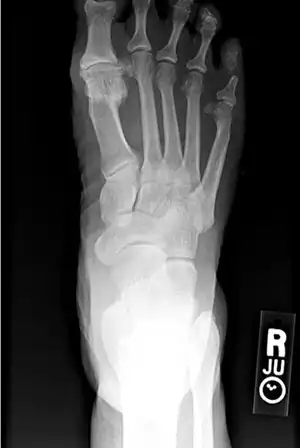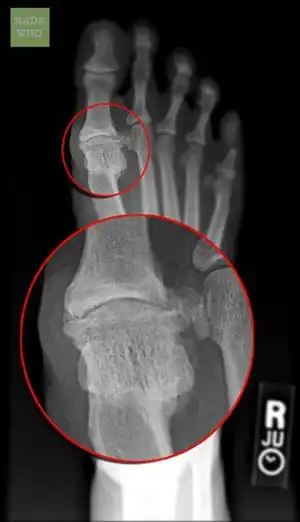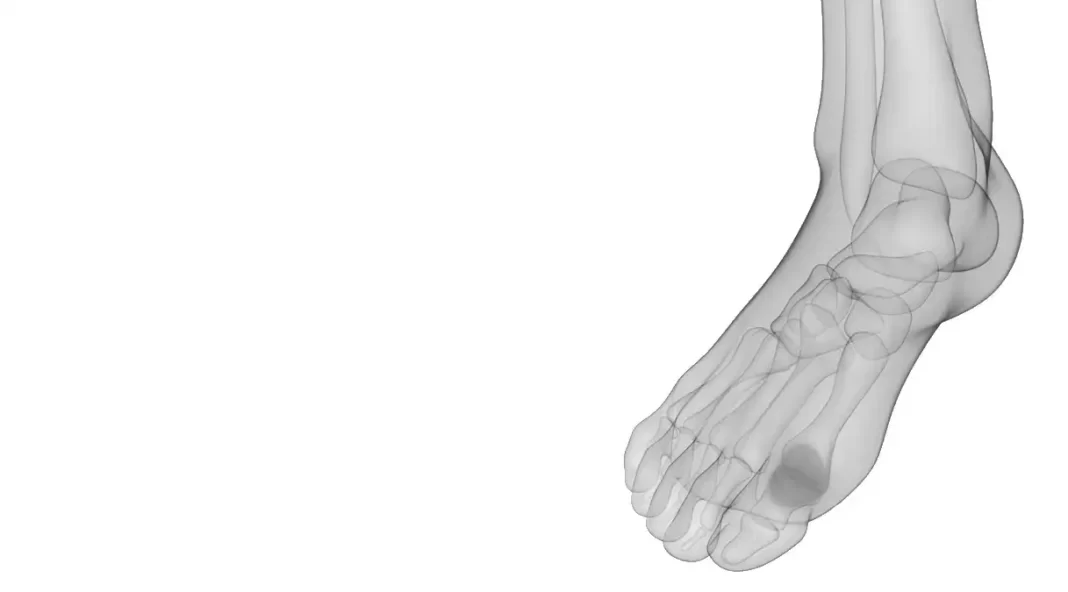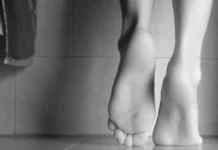Hallux rigidus, or degenerative arthritis of the metatarsophalangeal (MTP) joint of the big toe, is the most common manifestation of foot arthritis. In this condition, there is pain and stiffness in this joint of the big toe.
Introduction
The evolution of the Hallux, from the stage of Limitus to that of Rigidus, constitutes an interesting and often complex journey in the field of podiatry. Understanding this transition requires in-depth exploration of the anatomical mechanisms, risk factors and management strategies adapted to each stage of this disease continuum.
At the Hallux Limitus stage, we observe a progressive restriction of movement of the metatarsophalangeal (MTP) joint, the joint between the metatarsus and the phalanx of the big toe. This phenomenon can arise from a variety of causes, such as structural abnormalities, overuse, inappropriate footwear, or genetic factors. Early signs often include stiffness when flexing the big toe, pain when walking, and possibly bone spur formation.
As the Hallux progresses into the Rigidus stage, joint restriction becomes more pronounced, leading to a significant decrease in mobility of the big toe. Flexion and extension movements become increasingly limited, causing impaired walking and persistent pain. Patients may also experience a feeling of stiffness and locking in the joint during daily activities.
Risk factors for this transition include genetic predisposition, history of joint trauma, being overweight, inappropriate footwear, and sometimes underlying joint pathologies. Understanding these factors is crucial to developing a personalized management plan aimed at slowing the progression of Hallux Rigidus.
The main symptoms are pain and stiffness, especially when the toe moves in dorsiflexion. Hallux rigidus is the second most common condition of the big toe after hallux valgus.

Causes of hallus rigidus
Hallux rigidus is a painful condition of the big toe, characterized by joint stiffness and limitation of movement. Several factors can contribute to the development of this condition, and understanding these causes is essential for the prevention and effective management of hallux rigidus.
One of the major causes of hallux rigidus is wear and tear of the cartilage of the metatarsophalangeal joint of the big toe. This wear can result from age, normal wear and tear related to physical activity, or genetic factors predisposing to premature degeneration of cartilage. Over time, the decrease in articular cartilage leads to increased friction between bones, causing the stiffness and limitation of movement characteristic of hallux rigidus.
Joint trauma, such as severe sprains or fractures affecting the metatarsophalangeal joint, can also contribute to the development of hallux rigidus. Joint damage can disrupt the surface of the cartilage, accelerating its wear and promoting the formation of osteophytes, bony growths that can further restrict joint movement.
Joint deformity, often associated with a bunion deformity of the big toe (hallux valgus), may be an underlying cause of hallux rigidus. When the big toe is deviated outward, it can cause uneven pressure on the joint, contributing to cartilage wear and osteophyte formation.
Certain anatomical factors, such as an abnormality in the structure of the joint or a disproportionate length of the bones of the foot, can also increase the risk of hallux rigidus. Abnormal foot mechanics can lead to uneven wear and tear on the joint, leading to the development of this condition.
Arthritis, especially degenerative arthritis, is a common cause of hallux rigidus. Chronic joint inflammation can lead to cartilage breakdown, osteophyte formation, and limitation of movement. People with arthritis, especially those with a family history, are more likely to develop hallux rigidus.
High-impact physical activities, such as running or sports that involve frequent movement of the big toe, can contribute to the development of hallux rigidus by accelerating the wear and tear of the cartilage. People exposed to excessive stress on the metatarsophalangeal joint have an increased risk of developing this condition.
Diagnosis of hallux rigidus is based on a thorough clinical examination, a detailed medical history, and often imaging tests such as x-rays to assess the condition of the joint. Treatment for hallux rigidus can vary depending on the severity of symptoms, ranging from conservative measures such as wearing suitable shoes, orthotics and anti-inflammatory medications, to more invasive options like corticosteroid injection or surgery. in more advanced cases.
- Osteoarthritis: Osteoarthritis is the most common cause of hallux rigidus. It is a form of arthritis that occurs when the protective cartilage at the ends of bones deteriorates over time. When osteoarthritis affects the metatarsophalangeal joint, it can lead to stiffness and loss of mobility.
- Genetic Factors: Genetic predispositions can increase the risk of developing joint problems, including hallux rigidus.
- Trauma: Repeated injuries, trauma, or microtrauma to the big toe joint can contribute to the development of hallux rigidus.
- Structural Deformity: Some individuals may have an anatomical structure that predisposes to hallux rigidus, such as an abnormal MTP joint or foot deformity.
- Overuse: Excessive use of the joint from strenuous physical activities or repetitive movements can contribute to cartilage wear and stiffness.
- Inflammatory Diseases: Some inflammatory diseases, such as rheumatoid arthritis, can affect joints in the body, including the metatarsophalangeal joint.
- Underlying Medical Conditions: Medical conditions such as gout or Wilson’s disease can cause crystal deposits in the joint, leading to inflammation and damage.
- Bunion: A bunion, also called hallux valgus, is a deformity where the big toe tilts toward the other toes. This can increase pressure on the big toe joint and contribute to hallux rigidus.
Symptoms of hallus rigidus
- Pain: Pain is one of the most common symptoms of hallux rigidus. The pain may be felt in the front of the foot, at the big toe joint, and it may increase when walking, running, or flexing the big toe.
- Stiffness: Joint stiffness, particularly when flexing the big toe upward, is characteristic of hallux rigidus. Stiffness can limit joint mobility.
- Swelling: The affected joint may experience swelling, especially after physical activity or prolonged use.
- Loss of Mobility: Due to stiffness and pain, there may be a gradual loss of mobility in the big toe. The ability to fully bend or extend the toe may be compromised.
- Bone Spurs (Osteophytes): Over time, bony growths, called osteophytes, can form around the joint. These growths may be palpable and contribute to limitation of mobility.
- Difficulty Wearing Suitable Shoes: Due to deformity and pain, it may be difficult to wear normal shoes, which may lead to a search for wider or more comfortable shoes.
- Lameness: Some individuals may develop a limp to avoid putting too much weight on the painful joint.
- Toe Deformity (Hallux Valgus): In some cases, hallux rigidus can be associated with a deformity known as hallux valgus, where the big toe tilts toward the other toes.
Pathophysiology of hallus rigidus
The pathophysiology of hallux rigidus involves several steps that lead to stiffness and pain in the joint at the base of the big toe. Here is a step-by-step explanation of the pathophysiology of hallux rigidus:
- Degradation of Articular Cartilage:
- Stage 1: Cartilage Deterioration – The process begins with the progressive deterioration of the articular cartilage at the end of the first metatarsal and first phalanx, forming the metatarsophalangeal (MTP) joint of the big toe.
- Stage 2: Loss of Elasticity – Cartilage loses its elasticity and ability to absorb shock, leading to decreased cushioning between the bones during movement.
- Formation of Osteophytes (Bone Spurs):
- Stage 3: Osteoarticular Reaction – In response to cartilage degeneration, the body can form osteophytes, also called bone spurs. These bony growths can grow around the joint, causing the bone to increase in size.
- Reduction in Joint Space:
- Stage 4: Reduction of Joint Space – Loss of cartilage and formation of osteophytes reduces the joint space between the bones of the joint. This leads to increased friction between bone surfaces during movement.
- Joint Inflammation and Stiffness:
- Stage 5: Inflammation – The breakdown of cartilage can trigger an inflammatory response, leading to inflammation of the synovial membrane (synovitis) that lines the joint.
- Stage 6: Joint Stiffness – Inflammation contributes to joint stiffness, limiting the range of motion of the big toe.
- Structural Changes:
- Step 7: Response of Surrounding Structures – Surrounding structures, including ligaments, tendons and muscles, can respond to changes in the joint by adapting, but these adaptations can lead to imbalances and loss of stability.
- Pain and Impairment of Function:
- Stage 8: Pain – The combination of cartilage degeneration, inflammation, osteophyte formation, and structural changes contributes to persistent pain around the joint.
- Stage 9: Impaired Function – Symptoms, including pain and stiffness, lead to impairment of the normal function of the big toe, affecting walking and other activities.
- Evolution towards Severe Osteoarthritis:
- Stage 10: Progression of Osteoarthritis – Over time, joint degeneration can progress, leading to severe osteoarthritis with significant impairment of joint structure and function.
Recommendations for those with hallus rigidus
- Appropriate Footwear: Opt for shoes that provide good support, ample toe room and a cushioning sole. Shoes with a wide toe box can help reduce pressure on the big toe joint.
- Orthopedic Insoles: Orthopedic insoles or special pads can provide additional support and help distribute pressure more evenly across the foot.
- Avoid High Heels: High heels can increase pressure on the big toe joint. It is best to opt for shoes with low or flat heels.
- Weight Management: Maintain a healthy weight to reduce the load on the big toe joint. Losing weight can help reduce pressure on the joint.
- Anti-inflammatory Medications: Nonsteroidal anti-inflammatory medications (NSAIDs), such as ibuprofen, can help reduce pain and inflammation. However, it is important to use them under the supervision of a healthcare professional.
- Ice: Apply ice to the painful joint to reduce inflammation. Avoid placing ice directly on the skin and use a cold compress for 15 to 20 minutes at a time.
- Avoid High-Impact Activities: Avoid activities that put excessive strain on the joint, such as running on hard surfaces. Instead, opt for low-impact activities like swimming or cycling.
- Strengthening Exercises: Muscle strengthening exercises, particularly for the foot and ankle muscles, can help improve joint stability.
- Orthotics and Splints: Special orthotics or splints can provide additional support to the joint and help prevent excessive deviation of the big toe.
- Surgery: In severe cases where pain is persistent and mobility is severely limited, surgery may be considered to repair or replace the joint.
Diagnosis and treatment of hallus rigidus
Diagnostic :
- Physical examination :
- A thorough examination of the big toe area, assessing mobility, stability, and the presence of pain.
- Medical imaging :
- X-rays help visualize the extent of joint wear, the formation of osteophytes (bony growths), and other degenerative changes.
- Gait and Posture Assessment:
- Some healthcare professionals may assess the patient’s gait and posture to understand the impact of the condition on the way they walk.
Treatment :
Treatment for hallux rigidus may vary depending on the severity of the symptoms and the progression of the disease. Here are some possible approaches:
- Drugs :
- Nonsteroidal anti-inflammatory drugs (NSAIDs) may be prescribed to relieve pain and reduce inflammation.
- Orthotics and Adapted Shoes:
- Using special orthotics or shoes with a wider toe box can help reduce pressure on the joint.
- Osteopathy:
- Specific exercises may be recommended to strengthen the foot muscles, improve mobility and promote a more natural gait.
- Intra-articular injections:
- Corticosteroid injections may be given directly into the joint to relieve inflammation and pain.
- Plantar orthoses :
- Custom orthotic insoles can help redistribute pressure across the joint and improve support for the foot.
- Lifestyle Changes:
- Avoid activities that aggravate pain, such as high-heeled shoes, and maintain optimal body weight.
- Surgery :
- If symptoms are severe and persistent, surgery may be considered. Procedures vary and may include removal of osteophytes, arthrodesis (fusion of the joint), or in some cases, prosthesis of the joint.
Exercise and stretching to prevent rigidus
Prevention of hallux rigidus, a condition characterized by stiffness and pain at the joint at the base of the big toe, may involve exercises and stretches aimed at strengthening the muscles of the foot, improving joint mobility, and maintaining proper posture. Here are some exercises and stretches that can be beneficial in preventing hallux rigidus:
Muscle Strengthening Exercises:
- Toe Elevation:
- Sitting or standing, slowly lift your toes upward, contracting the muscles at the top of your foot. Hold the position for a few seconds and release. Repeat several times.
- Marble Pickup:
- Use your toes to pick up small objects such as marbles or small toys from the floor. This strengthens the toe muscles.
- Roller under the Foot:
- Roll a tennis ball or roller under the foot, using gentle pressure. This can help release tension and improve flexibility.
- Toe Stretch:
- Sit or stand. Gently grab one toe and stretch it toward you, holding the position for 15 to 30 seconds. Repeat with each toe.
Stretches to Improve Joint Mobility:
- Anterior Tibial Stretch:
- Stand with the top of your foot against a surface and bend your knee slightly forward. This stretches the tibialis anterior muscle.
- Calf Stretch:
- Stand facing a wall, feet apart, with your hands resting on the wall. Bend one knee while keeping the other leg straight behind you, stretching the calf.
- Ankle Rotation:
- Sitting or standing, rotate your ankles in a circular motion in either direction to maintain flexibility.
- Stretching the sole of the foot:
- Sit on your heels, stretching the soles of your feet. Hold the position for 15 to 30 seconds.
Additional Tips:
- Appropriate Footwear:
- Opt for comfortable shoes with a toe box wide enough to avoid compression of the joint.
- Weight Control:
- Maintaining optimal body weight can reduce pressure on the feet.
- Warm-up Before Exercise:
- Before any physical activity, be sure to do warm-ups to prepare the muscles and joints.
- Medical consultation :
- If you experience hallux rigidus symptoms or have concerns, consult a healthcare professional for personalized diagnosis and advice.
These exercises and stretches can help maintain flexibility and strength in the feet, reducing the risk of developing hallux rigidus.
X-ray sign of hallus rigidus
- Joint Space: The gap between the bony surfaces of the metatarsophalangeal (MTP) joint is assessed. In the case of hallux rigidus, a reduction in joint space may indicate cartilage degeneration.
- Bone Spurs (Osteophytes): Osteophytes, or bony growths, can form around the joint in response to cartilage degeneration. These bone spurs may be visible on x-rays.
- Joint Deformation: X-rays make it possible to visualize the deviation or deformation of the big toe joint. An upward deviation or changes in normal alignment may be observed.
- Signs of Osteoarthritis: Signs of osteoarthritis, such as the presence of bone sclerosis (hardening of the bones) and changes in the shape of the joint surfaces, may be detected.
- Bone Alignment: The alignment of the bones of the foot, particularly the position of the first phalanx in relation to the metatarsal, can be assessed to identify any structural abnormalities.
- Other Structures: X-rays may also show other surrounding bony structures, such as adjacent joints and bones of the foot.


References
- Kunnasegaran R, Thevendran G. HalluxRigidus: Nonoperative Treatment and Orthotics. Foot Ankle Clin. 2015 Sep;20(3):401-12. [ PubMed ]
- Mann RA. Disorders of the First Metatarsophalangeal Joint. J Am Acad Orthop Surg. 1995 Jan;3(1):34-43. [ PubMed ]
- Lam A, Chan JJ, Surace MF, Vulcano E. Halluxrigidus: How do I approach it? World J Orthop. 2017 May 18;8(5):364-371. [ PMC free article ] [ PubMed ]
- Coughlin MJ, Shurnas PS. Hallux rigidus: demographics, etiology, and radiographic assessment. Foot Ankle Int. 2003 Oct;24(10):731-43. [ PubMed ]
- Yee G, Lau J. Current concepts review: hallux rigidus. Foot Ankle Int. 2008 Jun;29(6):637-46. [ PubMed ]
- Coughlin MJ, Shurnas PS. Hallux rigidus. J Bone Joint Surg Am. 2004 Sep;86-A Suppl 1(Pt 2):119-30. [ PubMed ]
- Coughlin MJ, Shurnas PS. Hallux rigidus. Grading and long-term results of operative treatment. J Bone Joint Surg Am. 2003 Nov;85(11):2072-88. [ PubMed ]
Multiple Choice Questions (A to E)
- What is hallux rigidus?
- A) A deformation of the big toe
- B) Inflammation of the joints
- C) Degenerative arthritis of the big toe
- D) A bone spur
- E) A genetic disease
- What is the stage preceding hallux rigidus in its development?
- A) Hallux Limitus
- B) Hallux Valgus
- C) Hallux Flexus
- D) Hallux Varus
- E) Hallux Extremus
- What are the first events at the Hallux Limitus stadium?
- A) Swelling and itching
- B) Stiffness when flexing the big toe and pain when walking
- C) Change in skin color
- D) Numbness of the toes
- E) Visible bone spurs
- What factors can contribute to the transition to Hallux Rigidus?
- A) Excessive sugar consumption
- B) Genetic predisposition, excess weight, joint trauma
- C) Exposure to the sun
- D) Wearing jewelry on your feet
- E) Regular yoga practice
- What is the first step in the pathophysiology of hallux rigidus?
- A) Formation of bone spurs
- B) Cartilage deterioration
- C) Reduction of joint space
- D) Osteoarticular reaction
- E) Inflammation and joint stiffness
- How is the progression towards severe osteoarthritis characterized?
- A) Increased joint flexibility
- B) Significant decrease in joint structure
- C) Loss of cartilage elasticity
- D) Improved big toe function
- E) Total absence of pain
- What is the most common cause of hallux rigidus?
- A) Genetic factors
- B) Structural deformation
- C) Overuse
- D) Inflammatory diseases
- E) Osteoarthritis
- What symptoms are characteristic of hallux rigidus?
- A) Redness and warmth around the joint
- B) Progressive loss of vision
- C) Pain, stiffness, swelling, difficulty wearing shoes
- D) Tingling in the toes
- E) Rashes on the foot
- What recommendation is given for the management of hallux rigidus?
- A) Regular use of high heels
- B) Avoid low-heeled shoes
- C) Maintain a high body weight
- D) Avoid high-impact activities
- E) Apply heat to the painful joint
- What can be assessed using radiographic signs of hallux rigidus?
- A) Blood pressure
- B) Cholesterol level
- C) Joint space, bone spurs, bone alignment
- D) Heart rate
- E) Blood glucose level
Answers to Multiple Choice Questions
- What is hallux rigidus?
- C) Degenerative arthritis of the big toe
- What is the stage preceding hallux rigidus in its development?
- A) Hallux Limitus
- What are the first events at the Hallux Limitus stadium?
- B) Stiffness when flexing the big toe and pain when walking
- What factors can contribute to the transition to Hallux Rigidus?
- B) Genetic predisposition, excess weight, joint trauma
- What is the first step in the pathophysiology of hallux rigidus?
- B) Cartilage deterioration
- How is the progression towards severe osteoarthritis characterized?
- B) Significant decrease in joint structure
- What is the most common cause of hallux rigidus?
- E) Osteoarthritis
- What symptoms are characteristic of hallux rigidus?
- C) Pain, stiffness, swelling, difficulty wearing shoes
- What recommendation is given for the management of hallux rigidus?
- D) Avoid high-impact activities
- What can be assessed using radiographic signs of hallux rigidus?
- C) Joint space, bone spurs, bone alignment

























